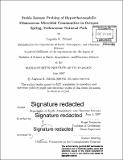Stable isotope probing of hyperthermophilic filamentous microbial communities in Octopus Spring, Yellowstone National Park
Author(s)
Dibbell, Augusta K
DownloadFull printable version (3.079Mb)
Other Contributors
Massachusetts Institute of Technology. Department of Earth, Atmospheric, and Planetary Sciences.
Advisor
Roger Summons.
Terms of use
Metadata
Show full item recordAbstract
Stabe isotope probe (SIP) incubation studies were performed using ¹³C-labeled carbon substrates on hyperthermophilic filamentous streamer communities inhabiting Octopus Spring in Yellowstone National Park. Biomass was removed from the outflow stream and incubated at near-in situ conditions with labeled bicarbonate, formate, or acetate. Lipids from the biomass were extracted and analyzed using gas chromatography-mass spectroscopy (GC-MS) and gas chromatography-isotope ratio monitoring-mass spectroscopy(GC-IRMS). We observed incorporation of ¹³C-labeled acetate into the total biomass, archaeal lipids, and a small number of bacterial lipids, but no incorporation of labeled formate or bicarbonate. During 67 hours of incubation, 0.060 [mu]g of labeled acetate was incorporated by the archaeal and bacterial community. The lack of acetate incorporation by most bacteria, or formate and bicarbonate incorporation by any community member may reflect rates of carbon turnover, the carbon acquisition pathway used, or inhibition under experimental conditions,
Description
Thesis: S.B., Massachusetts Institute of Technology, Department of Earth, Atmospheric, and Planetary Sciences, 2007. Cataloged from PDF version of thesis. Includes bibliographical references (pages 49-50).
Date issued
2007Department
Massachusetts Institute of Technology. Department of Earth, Atmospheric, and Planetary SciencesPublisher
Massachusetts Institute of Technology
Keywords
Earth, Atmospheric, and Planetary Sciences.